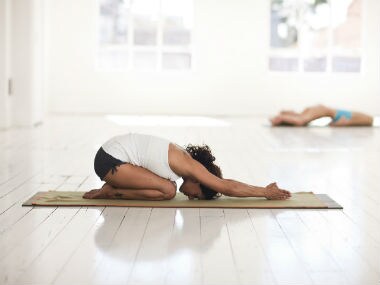Tensed up shoulders, an aching head, back and neck, could all be signs of stress. Of course, stressors can vary from person to person. For some, it could be the stress of work. Others might love their jobs but find that their bosses stress them out. If you have kids, you probably stress as much about their exams as they do. Or you might have an exam of your own coming up and be stressed about that. [caption id=“attachment_7353661” align=“alignleft” width=“380”]  Representational image. Image by AndiP from Pixabay[/caption] Whatever the reason, yoga offers a way to relieve some of that stress. As always, practising with a trained guru will give you peace of mind that you’re doing the postures correctly. Just one more thing to keep in mind, if you have very high or uncontrolled blood pressure, please consult your doctor before starting any workout. That said, here are six yoga poses that can bring you some relief from stress: Uttanasana or standing forward bend pose
- Stand on a mat with your feet slightly apart
- Breathe in as you raise your arms overhead
- Breathe out as you bend forward from the waist
- Try to touch the floor with your fingers. Shift your weight forward, towards the toes instead of the heels
- If you are comfortable in this pose, try to place your whole palm on the floor and bring your chest closer to your thighs
- Hold this position for 30 seconds. Slowly roll your body up, with the head coming up last
- Rest for a few seconds. Repeat twice
Prasarita padottanasana or wide-legged forward bend
- Stand on a mat with your legs wide apart
- If you are an advanced practitioner, interlock your fingers behind your back
- As you bend from the waist, lift your arms in the air. (Beginners and intermediate practitioners should try and place their hands flat on the floor)
- Go as far down as you can comfortably. Feel the stretch on your hamstrings, chest and shoulders
- Hold this position for 30 seconds to a minute. To come back to the starting position, release the arms, roll the body up and finally straighten your neck
Sasangasana or rabbit pose
- Kneel on the mat with the tops of your feet flat on the mat. (Do not curl your toes)
- Bend from the waist and place your forehead on the mat
- Take your arms back, and hold the heels in each hand
- Lift the hips slightly as you roll your head forward gently, to bring the top of your head on the mat
- Curve your back and breathe comfortably
- Hold this pose for 30 seconds to a minute
- To come back to starting position, trace your steps back: roll your head back to touch the forehead to the mat as you lower the hips back on to the heels. Release the arms. Gently roll up to come upright, into the kneeling position
Trikonasana or triangle pose
- Stand with your legs wide apart
- Turn the right foot out as you lift both arms parallel to the floor
- Bend sideways from the waist to touch your right foot with your right hand. If you are comfortable in this pose, place your right palm on the floor, in front of your right foot
- Lift the left arm straight up. Now, turn your head to look up at the ceiling
- Come back to starting position, and repeat on the left
- Do three repetitions on each side
Halasana or plough pose
- This is a slightly advanced pose. Beginners should follow the steps up to the shoulder stand, and try the plough pose after at least one week of regular yoga practice. It is also a good idea to have someone present who can help you in this pose, by holding your ankles for extra support or to help you come out of the pose safely
- Lie down on your back
- Rock forward and back slightly to build momentum and lift your legs and hips up into the air. Support your back with your hands and tuck your chin into your chest
- Keep lifting your legs higher till most of your back is off the mat and your weight is balanced in-between your shoulders and elbows (This is the shoulder stand; beginners should practice this for a few days or weeks, before gradually progressing to the next level)
- When you feel comfortable, try and drop one leg to the floor, beside your ear
- Switch legs, and do the same with the other leg
- When you are comfortable doing this, drop both your legs so the feet touch the floor on either side of your head
- Try to keep the knees straight and remember to breathe normally throughout
- Hold this position for a few seconds. If it’s easier for you to count breaths, hold for 10 slow breaths
- To come out of the pose, slowly lift your legs back into the shoulder stand
- Use your hand to support your back as you gently bring it on to the mat. Place your arms on the mat on either side of your body
- Next, slowly lower the legs back on to the mat
- Rest in savasana of sleeping pose for a few seconds
Supta Baddha Konasana or reclining bound angle pose
- Lie down on your back with your legs extended
- Bend your knees to place the soles of your feet next to each other on the mat
- Now gently lower the thighs to either side and join the soles of your feel. Make sure your lower back is on the mat
- Place the arms on the floor, in line with your shoulder or a little bit below your shoulder
- Breathe into this posture, keeping your lower back on the floor. (Beginners may also keep their hands - palms facing down - underneath their hips for support)
- Hold for 30 seconds to a minute
- Bring the knees together and rest for a few seconds before doing four more repetitions
To end your practice, lie down on the mat with your legs apart, arms at a 40-50 degree angle to your sides. Try to relax and breathe deeply in savasana or the sleeping pose. Stay there for at least five minutes. Health articles in Firstpost are written by myUpchar.com, India’s first and biggest resource for verified medical information. At myUpchar, researchers and journalists work with doctors to bring you information on all things health. Read our in-depth article on stress here.


)

)
)
)
)
)
)
)
)



